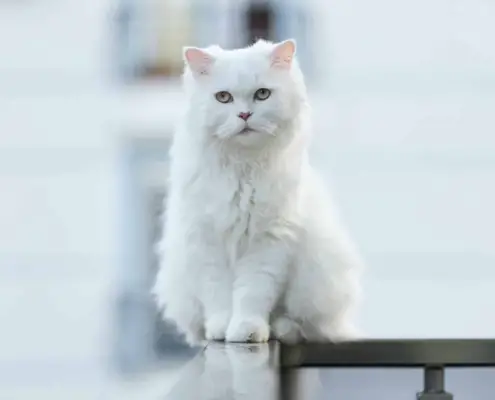
The heat cycle, also known as estrus, in female cats is a fascinating and crucial aspect of their reproductive system. It is a period when a female cat becomes fertile and ready to mate. Understanding the timing of a female cat’s heat cycle is essential for both cat owners and breeders. This article will delve into the intricacies of the heat cycle, shedding light on its stages, signs, and factors that influence its timing.
Understanding the reproductive system of female cats
To comprehend the heat cycle in female cats, it is vital to have a basic understanding of their reproductive system. A female cat’s reproductive system consists of ovaries, fallopian tubes, uterus, and vagina. The ovaries produce eggs, which are released during the heat cycle. If fertilization occurs, the eggs travel through the fallopian tubes to the uterus for implantation. If no fertilization occurs, the uterus sheds its lining, resulting in a heat cycle.
Signs and symptoms of a female cat in heat
When a female cat enters the heat cycle, there are several noticeable signs and symptoms. One of the most prominent indications is vocalization, where the cat meows loudly and persistently to attract potential mates. Additionally, a female cat in heat may display increased affection towards her owner, rubbing against them more frequently. Another common symptom is restlessness, with the cat constantly moving and pacing around the house. Moreover, a cat in heat may assume a characteristic mating position, known as “lordosis,” where she lowers her front body and raises her hindquarters.
The stages of the heat cycle in female cats
The heat cycle in female cats can be divided into four stages: proestrus, estrus, metestrus, and anestrus. Proestrus is the initial stage and can last for one to two days. During this stage, the female cat may display signs of restlessness and increased vocalization. Following proestrus is the estrus stage, which typically lasts for four to ten days. This is when the cat is most fertile and receptive to mating. Metestrus is a short transitional phase, lasting one to two days, where the cat’s fertility decreases. Finally, anestrus is the period of sexual inactivity, lasting for several weeks to months, before the cycle repeats.
How often do female cats go in heat?
The frequency of a female cat’s heat cycle depends on various factors, including her breed, age, and environmental conditions. Generally, female cats experience their first heat cycle between the ages of five to ten months. However, certain breeds may reach sexual maturity earlier or later. Once the heat cycle begins, it typically recurs every two to three weeks, unless the cat becomes pregnant or is spayed. It is important to note that some female cats can experience continuous heat cycles, known as “polyestrous,” while others may have seasonal cycles, known as “seasonally polyestrous.”
Factors that influence the timing of a female cat’s heat cycle
Several factors can influence the timing of a female cat’s heat cycle. One significant factor is the length of daylight. Cats are known as “photoperiodic” animals, meaning their reproductive hormones respond to changes in daylight duration. As the days become longer, female cats are more likely to enter the heat cycle. Additionally, environmental factors, such as temperature and the presence of male cats, can also influence the timing of a female cat’s heat cycle. Stress, illness, and certain medications can disrupt the regularity of the cycle as well.
How to determine if your female cat is in heat
Recognizing the signs of a female cat in heat is crucial for cat owners. One of the most reliable indicators is vocalization, as mentioned earlier. If your cat starts meowing excessively and in a different tone than usual, it may be a sign of her being in heat. Another method to determine if your female cat is in heat is by observing her behavior towards male cats. A cat in heat will often display a heightened interest in male cats, seeking their attention. Additionally, physical changes, such as swollen genitals and an increase in urination, can also indicate a cat’s heat cycle.
Tips for managing a female cat in heat
Managing a female cat in heat can be challenging, but there are several tips that can help alleviate some of the associated difficulties. Providing a safe and comfortable space for your cat is crucial during this time. Ensure that your cat is indoors to prevent any unwanted mating or potential dangers. Engaging your cat in play and providing mental stimulation can also help distract her from the discomfort of being in heat. Additionally, maintaining a calm and stress-free environment can mitigate any behavioral issues that may arise.
The importance of spaying your female cat
Spaying, or ovariohysterectomy, is the surgical removal of a female cat’s ovaries and uterus. It is a procedure recommended by veterinarians to prevent unwanted pregnancies and improve the overall health of the cat. Spaying your female cat not only eliminates the heat cycle but also reduces the risk of certain reproductive diseases, such as pyometra and mammary tumors. Moreover, spaying helps control the population of stray cats and reduces the urge for your cat to roam and potentially get into accidents.
Conclusion
Understanding when and how female cats go into heat is essential for cat owners and breeders alike. By familiarizing yourself with the signs and stages of the heat cycle, you can better manage your cat’s reproductive health. Remember to spay your female cat to ensure her well-being and prevent unwanted pregnancies. By unraveling the mysteries of the heat cycle, you can provide the best care and support for your feline companion.
If you enjoyed my article, I would appreciate you sharing it with your network.

Sima Ndlebe
Sima writes for CatBuzz. He is interested in Cats, Health and Fitness, and Entrepreneurship.
Published: 6 June 2024



